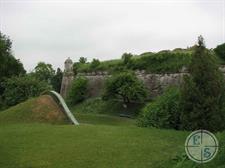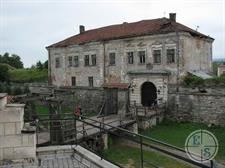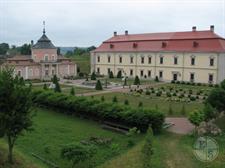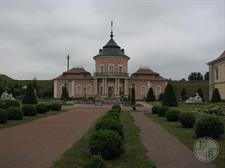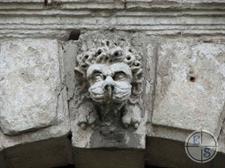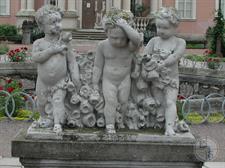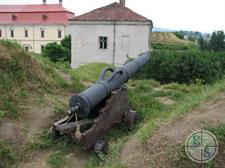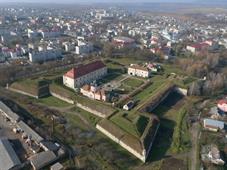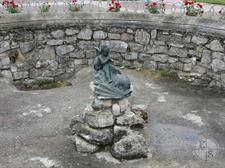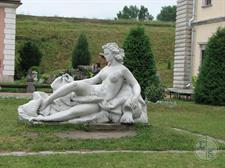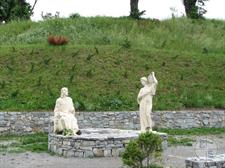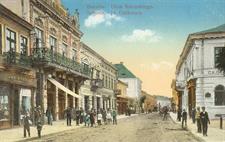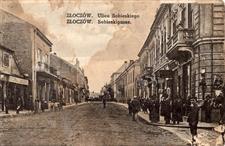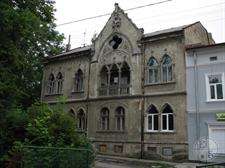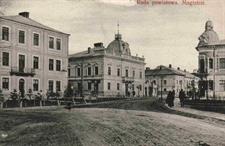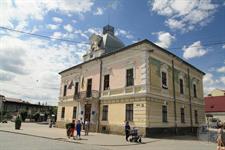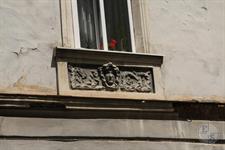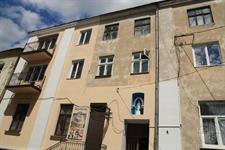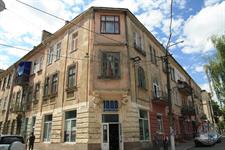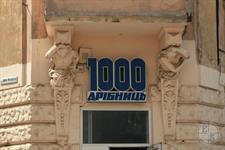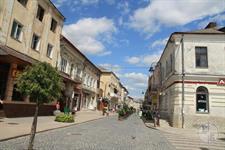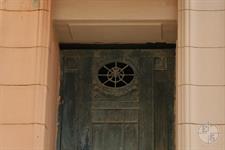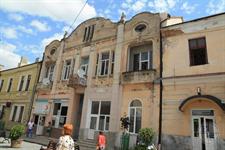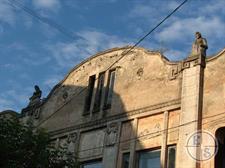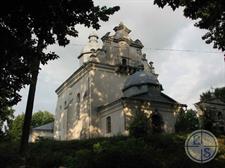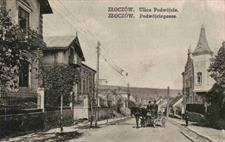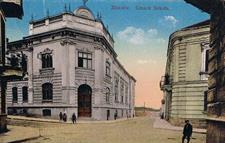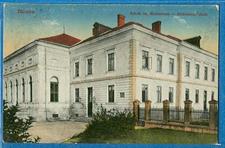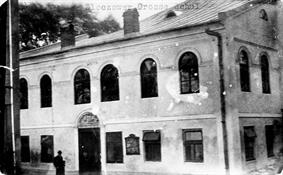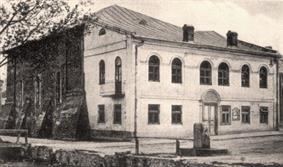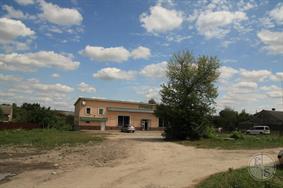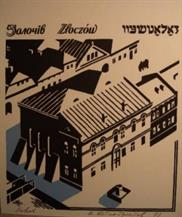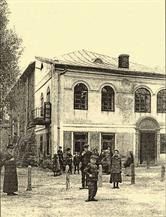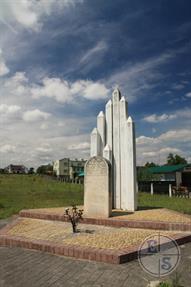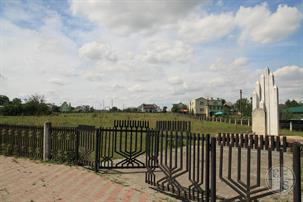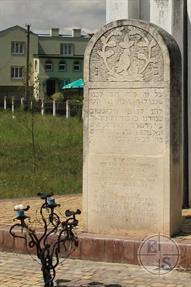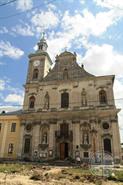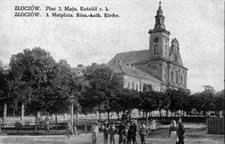Year - Total Population - Jews
1765 - (?) 1,380
1810 - (?) 1,480
1880 - 8,347 - 4,046
1890 - 10,113 - 5,086
1900 - 11,842 - 5,401
1910 - 12,234 - 5,243
1921 - 11,130 - 5,744
1931 - (?) - 5,700
1765 - (?) 1,380
1810 - (?) 1,480
1880 - 8,347 - 4,046
1890 - 10,113 - 5,086
1900 - 11,842 - 5,401
1910 - 12,234 - 5,243
1921 - 11,130 - 5,744
1931 - (?) - 5,700
Zolochiv
Lviv region
Zloczow (ukr. Zolochiv, Золочів) was mentioned as a town in the fifteenth century, but gained the status of a city in 1523. It held two trade fairs a year and a weekly market day. During the sixteenth century the town was damaged heavily by the invasions of the Tartars. The Sobieski family became the owners in 1598. A citadel was built to guard the town from enemies and invasions, and in 1649 the Cossacks captured the town. In that year there was a plague that badly injured those who survived the war. From 1687 until the end of the eighteenth century there was also an Armenian community. The town also suffered frequent fires. The biggest fires that damaged the whole town broke out in 1672, 1691, 1797, and 1903. After the last fire the town was rebuilt, and instead of wooden houses, the dwellings were built of brick. In 1914 the town was captured by the Russian army, which held it for a year. After a short period of Ukrainian rule (November 1918 to May 1919) the town returned to Polish rule.
The first Jew in Zloczow was a Jew from Lvov, Israel Ben Josef, who was nicknamed Eideles V'Zlutchevsky. He rented fish ponds and estates and was a moneylender to estate owners. Apparently by 1565 there was a little Jewish settlement in Zloczow. It is known that the Jewish community paid six zlotys as a head tax.
The real start of Jewish settlement was at the beginning of the seventeenth century. Even before the Chelminitski massacres, there was a wooden synagogue in Zloczow-, which was built in 1613- and also a cemetery, and a Jewish bathhouse.
The first information about Jews living in Zloczow was from 1550. The owner, Sobieski, donated or renewed the privilege of settlement (the documents which described the rights of the Jewish community) in 1654. According to it the Jews were permitted to live everywhere in the city, as well as to bring their relatives and friends, and rebuild the community institutions. They also were permitted to trade in everything except Christian religious objects. They could be artisans in every profession. When there was a conflict between a Jew and a Christian, the arbitrator was the owner of the town or his representative. The Jews were also permitted to take part in elections to the town institutions. They obligated themselves to defend the town, and so every Jew had to keep arms and ammunition in his home.
The town owner, King Jan Sobieski, ratified this privilege in 1681. In 1727 the synagogue burned, and the owner of the city donated wood for rebuilding it.
As Jewish settlement in Zloczow continued to develop, there were 209 big buildings, and Jews owned 70 of them, as well as 60 little buildings owned by Jews and Christians in the middle of the eighteenth century.
The main source of income for the local Jews was trade, especially the wholesale trade in agricultural products, some of which were sent to Silesia and Gdansk. Zloczow Jews traded in cereals, honey, and wax, pig bristles, and mules. Some made their livelihood in small trade, and others were artisans. At the end of this era the Jews built a glass industry and a few saw mills. The Jewish artisans were organized according to their professions, which paralleled the guilds of the Armenians and other city folk.
This community was under the jurisdiction of the Lvov community. In 1726 there was a meeting of the Reissen- State (White Russia). In 1739 Avraham of Zloczow was the head of the Reissen State. Rabbi Eleazar of Zloczow was very famous in this period. His nickname was HaGaon of Zloczow, and his famous book was Shever Luchot (Broken Tablet). He was murdered in Nemirov during the Chelminitski Pogrom in 1648-49. Another famous rabbi was Moshe Elhanon Halperin, who was rabbi in Zloczow during the years 1690-1710. From there he went to Sherigrod.
Another famous sage was Rabbi Meir Ben Shmuel Shmelki Horowitz, who was in the city 1710-1718. From there he went to Tikochin. Rabbi Moshe Ben Eleazar Rokach was elected in his place, whose famous book was called Ma'ase Rokach. He was the rabbi there until 1740. His grandson, or the son of his grandson, established the Hassidic dynasty of Belz.
Also worthy of mention was the sage, Rabbi Arie Konshuger, whose book, Ateret Zkenim, is a commentary of the Mishna. Reb Arie Konshuger lived in Zloczow as a private person after he was a rabbi in Konshuger and Herubiashov. Rabbi Arie had many disciples in who came to Zloczow to learn Halacha from him.
The first Jew in Zloczow was a Jew from Lvov, Israel Ben Josef, who was nicknamed Eideles V'Zlutchevsky. He rented fish ponds and estates and was a moneylender to estate owners. Apparently by 1565 there was a little Jewish settlement in Zloczow. It is known that the Jewish community paid six zlotys as a head tax.
The real start of Jewish settlement was at the beginning of the seventeenth century. Even before the Chelminitski massacres, there was a wooden synagogue in Zloczow-, which was built in 1613- and also a cemetery, and a Jewish bathhouse.
The first information about Jews living in Zloczow was from 1550. The owner, Sobieski, donated or renewed the privilege of settlement (the documents which described the rights of the Jewish community) in 1654. According to it the Jews were permitted to live everywhere in the city, as well as to bring their relatives and friends, and rebuild the community institutions. They also were permitted to trade in everything except Christian religious objects. They could be artisans in every profession. When there was a conflict between a Jew and a Christian, the arbitrator was the owner of the town or his representative. The Jews were also permitted to take part in elections to the town institutions. They obligated themselves to defend the town, and so every Jew had to keep arms and ammunition in his home.
The town owner, King Jan Sobieski, ratified this privilege in 1681. In 1727 the synagogue burned, and the owner of the city donated wood for rebuilding it.
As Jewish settlement in Zloczow continued to develop, there were 209 big buildings, and Jews owned 70 of them, as well as 60 little buildings owned by Jews and Christians in the middle of the eighteenth century.
The main source of income for the local Jews was trade, especially the wholesale trade in agricultural products, some of which were sent to Silesia and Gdansk. Zloczow Jews traded in cereals, honey, and wax, pig bristles, and mules. Some made their livelihood in small trade, and others were artisans. At the end of this era the Jews built a glass industry and a few saw mills. The Jewish artisans were organized according to their professions, which paralleled the guilds of the Armenians and other city folk.
This community was under the jurisdiction of the Lvov community. In 1726 there was a meeting of the Reissen- State (White Russia). In 1739 Avraham of Zloczow was the head of the Reissen State. Rabbi Eleazar of Zloczow was very famous in this period. His nickname was HaGaon of Zloczow, and his famous book was Shever Luchot (Broken Tablet). He was murdered in Nemirov during the Chelminitski Pogrom in 1648-49. Another famous rabbi was Moshe Elhanon Halperin, who was rabbi in Zloczow during the years 1690-1710. From there he went to Sherigrod.
Another famous sage was Rabbi Meir Ben Shmuel Shmelki Horowitz, who was in the city 1710-1718. From there he went to Tikochin. Rabbi Moshe Ben Eleazar Rokach was elected in his place, whose famous book was called Ma'ase Rokach. He was the rabbi there until 1740. His grandson, or the son of his grandson, established the Hassidic dynasty of Belz.
Also worthy of mention was the sage, Rabbi Arie Konshuger, whose book, Ateret Zkenim, is a commentary of the Mishna. Reb Arie Konshuger lived in Zloczow as a private person after he was a rabbi in Konshuger and Herubiashov. Rabbi Arie had many disciples in who came to Zloczow to learn Halacha from him.
In 1772 when the area was annexed to Austria, Zloczow became the capital of a district, which included the large and important community of Brody. Although the city was the capital of a district, the Jewish community was under the jurisdiction of the Brody Jewish community.
The Jews of Zloczow continued to make their living by trade and artisanship. Tobacco was grown in the Zloczow area, and the Jews marketed it and manufactured cigarettes.
During the former Polish era, the trade was through Gdansk to the north, but during the Austrian rule, the trade went to the south. After the port of Odessa was constructed, the important merchants of Zloczow sold the agricultural produce through it. A leather industry was established in Zloczow. During the 1820's fifty thousand pieces were made annually. The Austrian government tried to make the Jews more productive. Twelve poor Jewish families were compelled to become farmers in 1809, but in 1822 only nine of them continued farming.
Remarkable economic development occurred during the 1870's. A chain of railroad lines was established. Among the contractors who supplied raw materials to the railroad (railway sleepers, gravel or concrete) were Jews. Many Jews also made their living driving a horse and cart, or coach for transporting raw materials to the railway. During this period the Austrian authorities began building army camps in the area, and Jews also made a living as cart or coach drivers and artisans, as well as carpenters, ironworkers, painters, and glaziers.
In 1903 the city was burned again, and again it was rebuilt with some help of the authorities, but mostly with the help of Jewish charitable institutions in Europe and Zloczow-born Jews who had immigrated to the United States. Brick houses were built instead of wooden houses, and brick factories were constructed as well.
A famous enterprise in Zloczow was Zuckerkandel's printing house, which was established in 1870. In 1875 it became a publishing house in the Polish language. From then until the First World War this publishing house put out a thousand books in the Polish language, the best works of classical and European literature. There were also two other printing houses, and their owners were Jews. During the 1880's the number of Jews in the free professions grew, and in 1914 there were seventy of them. In 1902 a mutual fund was established (for low- or no- interest loans). Three years later it was united with a similar fund of Y.I.K.A. (a global fund established by Baron Hirsh). In 1907 there were 436 members of this united fund, and it made 327 loans, which amounted to 101,610 Austrian crowns altogether. The Zionists established a bank called Ihud L' Asrey (Unity for Credit), whose members in 1913 included 789 merchants, 273 artisans, 76 free professionals, and 72 others.
At the end of the nineteenth century an artisan's organization was established in Zloczow called Yad Haruzim (industrious hand).
The Hassidic movement spread into Zloczow from its inception. The main reason for its popularity was Rabbi Yehiel Michel (the son of Rabbi Yitzhak of Drohowitz), whose nickname was Rabbi Michel, HaMaggid of Zloczow. He was born and lived in Brody, and was one of the famous disciples of the Besht and Maggid of Meszerich. But when the Mitnagdim burned the famous Hassidic book, Toldot Yakov Yosef near the entrance of his home, he moved to Zloczow where he was a Maggid (one who gives sermons). Rabbi Yehiel Michel had many disciples who established dynasties of Hassidic Admorim. His five sons were also admorim, four in the Volhin area, while one Rabbi Velverl established his Hassidic court in Zabrasczow in Galicia. Rabbi Michel died in Yampol, and was buried there.
Another famous rabbi in Zloczow during this era was one of the first Hassidic leaders, Issachar Ber. He was the disciple of the Maggid of Meszerich, and Rabbi Yehiel Michel, and he wrote the book Bat Eini, a commentary on SHAS (Mishna and Gomora), in the style of pilpul (disputation). Another book he wrote was Mevasser Zadek, which includes his conversations and sermons on the Torah in the Hassidic spirit. At the end of his life, in 1807 he came with his son to Palestine and died in Safed in 1809. The next rabbi of Zloczow was his son-in-law, Rabbi Avram Haim, whose book was Orach Haim (The Way of Life). He was the disciple of Rabbi Yehiel Michel, and the brother of Rabbi Shmelka of Nikolsburg, and Rabbi Pinchas of Frankfort-on Maine. He was the rabbi in Zloczow for many years, and died in 1848, when he was 90 years old. The local Rabbi, Yoel Ashkenazi, the grandson of RabbiYakov Loberboim of Lissa, followed him. He wrote a book of answers to questions that were sent to him about Halachic problems. The name of this book was SHU'T MaAri Ashkenazi. The book was written in a very poetic and high-flown style. Rabbi Yoel died in Zloczow in 1803.
The next rabbi, Feivel Shraga Rohatyn, who was born in Lvov, symbolizes the transition to the modern era. When he was sixteen years old, he was ordained a rabbi, and when he was eighteen he was elected as rabbi of Narayov. When he was twenty-four, he was nominated as rabbi of Zloczow. During his reign in Zloczow he succeeded in an external examination for a high school certificate in the local gymnasium. Afterwards he won the title of Doctor of Philosophy for his research on the Rambam. He published a book of Halacha, Mispat Mechokek. Rabbi Shraga was also an important building contractor. As the result of the competition between him and other contractors in Zloczow, he was fired from the rabbinate in 1905 and returned to Lvov. In 1907 the community of Zloczow decided to return to its rabbi. He refused three delegations, and only after crowds of Zloczow Jews came to Lvov and implored him, returned to be the rabbi until his death in 1910. After him came the rabbi and head of the Bet Din of Zloczow, Rabbi Shmuel Shapira, (the rabbi of Dobromil), who held the position until his death in 1928.
Until the 1860's rich Hassidim, who were famous for their determined leadership, led the community. During the years 1831-1850 the community was led by Dov Ber Landau, whose nickname was Yiddishe Regirer, that is to say the “Jewish governor”. Herman Burshtein, also a Hassid, followed him until 1863. In that year the members of the organization Shomer Yisroel, among them the famous Yehuda Funkenshtein, and the last head of the community during the Austrian era, Yosef Gold. Yehuda Funkelshtein was rich and learned. His private library included books in German, Polish, and French. Many of the intelligensia of Zloczow used it. During his leadership Rabbi Uri of Stralisk (nicknamed Angel) came to visit him. Thanks to his connections with the authorities, Yehuda Funkelshtein succeeded in expelling Rabbi Uri from the city. One of the authors that wrote about this affair was Shai Agnon, in his story “Hanidach”. The son-in-law of Rabbi Yehuda Finkelshtein, Mordechai Muter, established the first bank in the city.
During the first election to the Municipality in 1873 the Jews got 13 mandates out of 30. At the end of the nineteenth century, the mayor was Dr. David Bilt, and after him, from 1906 until the end of the First World War, came Dr. Yosef Gold, the son-in-law of the head of the Jewish community, Josef Gold; both of them were leaders of the assimilationists in Zloczow.
In a special election to the Austrian Parliament Dr. Josef Gold was elected in the Zloczow-Brody area. In subsequent elections Dr. Adolf Shtand, the leader of Galizia Zionists, won a place.
Already by the end of the nineteenth century there were in Jews in Zloczow who were members of the Polish Socialist Party, P.P.S. In 1894, after there was a visit to the town by Dr. Moderchai Ehrenpreis and Dr. Yoshua Thorn, a Zionist Union, called Degel Yeshurun was established in Zloczow. In 1898 this union had 108 members. Another Zionist Union was established in the town: Ohel Leah, a women's union, and a high school group which united as Tsirei Zion, Young Zionists.
In 1904 a branch of Poalei Zion, the Zionist Workers' Party was established, and in 1908 it had 60 members. The branch had a drama circle and a Yiddish library. In 1810 a branch of Mizrachi was established. In 1905 a branch of the Jewish Socialist Party, J.P.S., was established.
Among the welfare institutions established in Zloczow during this period was the Jewish Hospital, which was established in 1885, and operated at irregular intervals. There was also was an old age home which also operated sporadically, an orphanage which was established at the end of this period, and after 1910 the organization Ezrat Yisroel, a charity.
After the failure of the school established by Herz Homberg at the beginning of the nineteenth century, the members of Shomer Yisroel tried to establish a secular Jewish school in 1869. The experiment failed and after a few years the school was closed. In 1883 a Gymnasia open to all included Jews as students. In 1891 a school for Jewish children was established by the Baron Hirsh fund. After a few years the lessons in this school were given only in Polish. A Jew from Zloczow who returned to the city from the United States, and was nicknamed Shmuel Amerikaner established a Heder Metukan (modern Heder) in 1904. In this heder Hebrew was taught in Hebrew. In 1908 the Zionists established a Hebrew school whose teacher, Naphtali Ziegel, was a pedagogue and author of Hebrew literature. In the beginning there was a competition between the two Hebrew school, but after a short time they united. In 1912 the school published a periodical in Hebrew, the Young Hebrew, whose editor was Naftali Ziegel.
The cultural and secular activity was concentrated in the society Hochma V'haskala, which was established in 1878 by Shomer Yisroel. After a short time the society stopped its activities, but it began them again in 1885. In 1911 the Toynbe- Halle was established, and in its first year of activity more than 2,000 people came to their lectures, a quarter of them women.
At the beginning of the First World War, Zloczow was captured by the Russian army, which stayed in the city more than a year. At the beginning of the Russian conquest, there was the false charge that the Jews shot at the Russian army, and for this reason they were in danger of being expelled. The good luck was that the Russian commander didn't believe this story, and the Jews were saved. The Russian army imprisoned many town notables, Jews and Poles, and expelled them into the interior of Russia. At this time many Jewish refugees arrived from Biali Kamen, which was burnt, and from Tishmienizer, and from Tlomash. An assistance committee was established to help those local Jews who had become refugees, aided by the Jewish committee in Kiev. The committee opened a soup kitchen, which gave out free hot meals.
The Jews of Zloczow continued to make their living by trade and artisanship. Tobacco was grown in the Zloczow area, and the Jews marketed it and manufactured cigarettes.
During the former Polish era, the trade was through Gdansk to the north, but during the Austrian rule, the trade went to the south. After the port of Odessa was constructed, the important merchants of Zloczow sold the agricultural produce through it. A leather industry was established in Zloczow. During the 1820's fifty thousand pieces were made annually. The Austrian government tried to make the Jews more productive. Twelve poor Jewish families were compelled to become farmers in 1809, but in 1822 only nine of them continued farming.
Remarkable economic development occurred during the 1870's. A chain of railroad lines was established. Among the contractors who supplied raw materials to the railroad (railway sleepers, gravel or concrete) were Jews. Many Jews also made their living driving a horse and cart, or coach for transporting raw materials to the railway. During this period the Austrian authorities began building army camps in the area, and Jews also made a living as cart or coach drivers and artisans, as well as carpenters, ironworkers, painters, and glaziers.
In 1903 the city was burned again, and again it was rebuilt with some help of the authorities, but mostly with the help of Jewish charitable institutions in Europe and Zloczow-born Jews who had immigrated to the United States. Brick houses were built instead of wooden houses, and brick factories were constructed as well.
A famous enterprise in Zloczow was Zuckerkandel's printing house, which was established in 1870. In 1875 it became a publishing house in the Polish language. From then until the First World War this publishing house put out a thousand books in the Polish language, the best works of classical and European literature. There were also two other printing houses, and their owners were Jews. During the 1880's the number of Jews in the free professions grew, and in 1914 there were seventy of them. In 1902 a mutual fund was established (for low- or no- interest loans). Three years later it was united with a similar fund of Y.I.K.A. (a global fund established by Baron Hirsh). In 1907 there were 436 members of this united fund, and it made 327 loans, which amounted to 101,610 Austrian crowns altogether. The Zionists established a bank called Ihud L' Asrey (Unity for Credit), whose members in 1913 included 789 merchants, 273 artisans, 76 free professionals, and 72 others.
At the end of the nineteenth century an artisan's organization was established in Zloczow called Yad Haruzim (industrious hand).
The Hassidic movement spread into Zloczow from its inception. The main reason for its popularity was Rabbi Yehiel Michel (the son of Rabbi Yitzhak of Drohowitz), whose nickname was Rabbi Michel, HaMaggid of Zloczow. He was born and lived in Brody, and was one of the famous disciples of the Besht and Maggid of Meszerich. But when the Mitnagdim burned the famous Hassidic book, Toldot Yakov Yosef near the entrance of his home, he moved to Zloczow where he was a Maggid (one who gives sermons). Rabbi Yehiel Michel had many disciples who established dynasties of Hassidic Admorim. His five sons were also admorim, four in the Volhin area, while one Rabbi Velverl established his Hassidic court in Zabrasczow in Galicia. Rabbi Michel died in Yampol, and was buried there.
Another famous rabbi in Zloczow during this era was one of the first Hassidic leaders, Issachar Ber. He was the disciple of the Maggid of Meszerich, and Rabbi Yehiel Michel, and he wrote the book Bat Eini, a commentary on SHAS (Mishna and Gomora), in the style of pilpul (disputation). Another book he wrote was Mevasser Zadek, which includes his conversations and sermons on the Torah in the Hassidic spirit. At the end of his life, in 1807 he came with his son to Palestine and died in Safed in 1809. The next rabbi of Zloczow was his son-in-law, Rabbi Avram Haim, whose book was Orach Haim (The Way of Life). He was the disciple of Rabbi Yehiel Michel, and the brother of Rabbi Shmelka of Nikolsburg, and Rabbi Pinchas of Frankfort-on Maine. He was the rabbi in Zloczow for many years, and died in 1848, when he was 90 years old. The local Rabbi, Yoel Ashkenazi, the grandson of RabbiYakov Loberboim of Lissa, followed him. He wrote a book of answers to questions that were sent to him about Halachic problems. The name of this book was SHU'T MaAri Ashkenazi. The book was written in a very poetic and high-flown style. Rabbi Yoel died in Zloczow in 1803.
The next rabbi, Feivel Shraga Rohatyn, who was born in Lvov, symbolizes the transition to the modern era. When he was sixteen years old, he was ordained a rabbi, and when he was eighteen he was elected as rabbi of Narayov. When he was twenty-four, he was nominated as rabbi of Zloczow. During his reign in Zloczow he succeeded in an external examination for a high school certificate in the local gymnasium. Afterwards he won the title of Doctor of Philosophy for his research on the Rambam. He published a book of Halacha, Mispat Mechokek. Rabbi Shraga was also an important building contractor. As the result of the competition between him and other contractors in Zloczow, he was fired from the rabbinate in 1905 and returned to Lvov. In 1907 the community of Zloczow decided to return to its rabbi. He refused three delegations, and only after crowds of Zloczow Jews came to Lvov and implored him, returned to be the rabbi until his death in 1910. After him came the rabbi and head of the Bet Din of Zloczow, Rabbi Shmuel Shapira, (the rabbi of Dobromil), who held the position until his death in 1928.
Until the 1860's rich Hassidim, who were famous for their determined leadership, led the community. During the years 1831-1850 the community was led by Dov Ber Landau, whose nickname was Yiddishe Regirer, that is to say the “Jewish governor”. Herman Burshtein, also a Hassid, followed him until 1863. In that year the members of the organization Shomer Yisroel, among them the famous Yehuda Funkenshtein, and the last head of the community during the Austrian era, Yosef Gold. Yehuda Funkelshtein was rich and learned. His private library included books in German, Polish, and French. Many of the intelligensia of Zloczow used it. During his leadership Rabbi Uri of Stralisk (nicknamed Angel) came to visit him. Thanks to his connections with the authorities, Yehuda Funkelshtein succeeded in expelling Rabbi Uri from the city. One of the authors that wrote about this affair was Shai Agnon, in his story “Hanidach”. The son-in-law of Rabbi Yehuda Finkelshtein, Mordechai Muter, established the first bank in the city.
During the first election to the Municipality in 1873 the Jews got 13 mandates out of 30. At the end of the nineteenth century, the mayor was Dr. David Bilt, and after him, from 1906 until the end of the First World War, came Dr. Yosef Gold, the son-in-law of the head of the Jewish community, Josef Gold; both of them were leaders of the assimilationists in Zloczow.
In a special election to the Austrian Parliament Dr. Josef Gold was elected in the Zloczow-Brody area. In subsequent elections Dr. Adolf Shtand, the leader of Galizia Zionists, won a place.
Already by the end of the nineteenth century there were in Jews in Zloczow who were members of the Polish Socialist Party, P.P.S. In 1894, after there was a visit to the town by Dr. Moderchai Ehrenpreis and Dr. Yoshua Thorn, a Zionist Union, called Degel Yeshurun was established in Zloczow. In 1898 this union had 108 members. Another Zionist Union was established in the town: Ohel Leah, a women's union, and a high school group which united as Tsirei Zion, Young Zionists.
In 1904 a branch of Poalei Zion, the Zionist Workers' Party was established, and in 1908 it had 60 members. The branch had a drama circle and a Yiddish library. In 1810 a branch of Mizrachi was established. In 1905 a branch of the Jewish Socialist Party, J.P.S., was established.
Among the welfare institutions established in Zloczow during this period was the Jewish Hospital, which was established in 1885, and operated at irregular intervals. There was also was an old age home which also operated sporadically, an orphanage which was established at the end of this period, and after 1910 the organization Ezrat Yisroel, a charity.
After the failure of the school established by Herz Homberg at the beginning of the nineteenth century, the members of Shomer Yisroel tried to establish a secular Jewish school in 1869. The experiment failed and after a few years the school was closed. In 1883 a Gymnasia open to all included Jews as students. In 1891 a school for Jewish children was established by the Baron Hirsh fund. After a few years the lessons in this school were given only in Polish. A Jew from Zloczow who returned to the city from the United States, and was nicknamed Shmuel Amerikaner established a Heder Metukan (modern Heder) in 1904. In this heder Hebrew was taught in Hebrew. In 1908 the Zionists established a Hebrew school whose teacher, Naphtali Ziegel, was a pedagogue and author of Hebrew literature. In the beginning there was a competition between the two Hebrew school, but after a short time they united. In 1912 the school published a periodical in Hebrew, the Young Hebrew, whose editor was Naftali Ziegel.
The cultural and secular activity was concentrated in the society Hochma V'haskala, which was established in 1878 by Shomer Yisroel. After a short time the society stopped its activities, but it began them again in 1885. In 1911 the Toynbe- Halle was established, and in its first year of activity more than 2,000 people came to their lectures, a quarter of them women.
At the beginning of the First World War, Zloczow was captured by the Russian army, which stayed in the city more than a year. At the beginning of the Russian conquest, there was the false charge that the Jews shot at the Russian army, and for this reason they were in danger of being expelled. The good luck was that the Russian commander didn't believe this story, and the Jews were saved. The Russian army imprisoned many town notables, Jews and Poles, and expelled them into the interior of Russia. At this time many Jewish refugees arrived from Biali Kamen, which was burnt, and from Tishmienizer, and from Tlomash. An assistance committee was established to help those local Jews who had become refugees, aided by the Jewish committee in Kiev. The committee opened a soup kitchen, which gave out free hot meals.
During the existence of the Western Ukrainian Republic (November 1918-May 1919) there were vibrant cultural activities among Zloczow's Jews. A Jewish school was established there whose languages were Yiddish and Hebrew, a kindergarten, and also instruction in accountancy. A soup kitchen was built for the needy. The parties renewed their activities, and also new organizations were established: Hashomer Hazair and Abir (a religious youth movement whose members prepared themselves for immediate aliyah), and Hitachadut. The J.P.S., renamed the Bund, also renewed its activity. The Zionists founded a Yiddish weekly, the Zlotchever Folksblat. The Toynbe- Halle also renewed its activity.
In March 1919 about 800 Ukrainian villagers burst into Zloczow and pillaged the town, especially the Jewish quarters. The Ukrainians also tortured the Poles, and a few of them including high school pupils, were then executed.
When the Polish army entered the town, its soldiers tortured the Jews, pulled their beards, sometimes to the skin, beat them, and robbed everything possible. The Jewish mayor, Dr. Josef Gold, was fired, although he was a proponent of Polish assimilation, and a commissar was nominated in his place. The Jewish pupils were expelled from the high school under the pretext that they served the Ukrainians.
During the Polish-Soviet War in 1920, the Red Army captured Zloczow. Its soldiers forced the Jews to dig defensive trenches, even on Saturdays and holidays. Jews who prayed were expelled from the synagogue to dig fortifications. All the shops that were owned by Jews were confiscated. The Christian shops were not confiscated. Thanks to the activities of the distinguished members of the community before the representatives of the government, Zloczow Jewry was not expelled to the interior of Russia. When the Polish army recaptured the town, this time it acted fairly to the Jewish population.
Between the two world wars, Zloczow Jewry continued to follow the same professions as it had in the past: trade, small business, artisanship, the free professions, clerks, and agriculture. In the beginning of the 20's there were 172 factory owners who employed 452 people, 62 of whom were family members, and 152 were Jewish workers and 64 non-Jewish. 160 people were employed in textiles, and after it food (62), building (41), and wood (29). In the market square there were 138 stores, all of them Jewish. The municipality tried to move the stall owners from this area to a place outside the city under the pretext of esthetic reasons. But this move would destroy their living of the stall owners.
At the beginning of the Polish state there were four Jewish banks in Zloczow, but all of them went bankrupt. The director and treasurer of one of them were arrested for embezzling money. Only two financial institutions lasted until the beginning of the Second World War, the Cooperative Commercial Bank, which was directed by Zionists, and the Free Loan Fund. The last was established in the mid 1920's, and gave 176 loans in 1936 for the sum of 23,445 Zlotys. The beneficiaries were 216 small businessmen, 70 artisans, 5 laborers, 4 farmers, and 20 others.
The Yad Haruzim Society was often split into Zionist and leftist factions. The union of merchants and industrialists split into Zionist and Agudat Yisroel Members. There were unions of employees, including trade workers and dental workers, etc.
The biggest of the Jewish parties in Zloczow was the General Zionists. It represented the Jews in the Municipality, directed the community, and was active in the unions of artisans and merchants. It also had a women's branch. The Mizrachi also had a youth branch, Bnai Akiva.
Gordonia was established in 1928, and similar youth movements were established later, Vitkinia and Buselia. Poalei Zion renewed its activity only in 1923. In 1924 Hechalutz Zloczow was established, as well as a union for aiding Olim to immigrate.
In 1930 a branch of Betar was opened in Zloczow, and a year later a branch of the Revisionist Party. When this party split 1933 there was a branch of the Jewish State Party in Zloczow.
A group of Hashomer Hazair members made aliyah in 1920. During the 30's Honoar Hazioni was the biggest youth movement in Zloczow. It had 170 members in 1933. It offered Hachsharat Haluzi (training on a farm for immigrating directly to a kibbutz). It can be learned around the proportions among the Zionist movements from the results of the elections to Zionist Congresses.
In March 1919 about 800 Ukrainian villagers burst into Zloczow and pillaged the town, especially the Jewish quarters. The Ukrainians also tortured the Poles, and a few of them including high school pupils, were then executed.
When the Polish army entered the town, its soldiers tortured the Jews, pulled their beards, sometimes to the skin, beat them, and robbed everything possible. The Jewish mayor, Dr. Josef Gold, was fired, although he was a proponent of Polish assimilation, and a commissar was nominated in his place. The Jewish pupils were expelled from the high school under the pretext that they served the Ukrainians.
During the Polish-Soviet War in 1920, the Red Army captured Zloczow. Its soldiers forced the Jews to dig defensive trenches, even on Saturdays and holidays. Jews who prayed were expelled from the synagogue to dig fortifications. All the shops that were owned by Jews were confiscated. The Christian shops were not confiscated. Thanks to the activities of the distinguished members of the community before the representatives of the government, Zloczow Jewry was not expelled to the interior of Russia. When the Polish army recaptured the town, this time it acted fairly to the Jewish population.
Between the two world wars, Zloczow Jewry continued to follow the same professions as it had in the past: trade, small business, artisanship, the free professions, clerks, and agriculture. In the beginning of the 20's there were 172 factory owners who employed 452 people, 62 of whom were family members, and 152 were Jewish workers and 64 non-Jewish. 160 people were employed in textiles, and after it food (62), building (41), and wood (29). In the market square there were 138 stores, all of them Jewish. The municipality tried to move the stall owners from this area to a place outside the city under the pretext of esthetic reasons. But this move would destroy their living of the stall owners.
At the beginning of the Polish state there were four Jewish banks in Zloczow, but all of them went bankrupt. The director and treasurer of one of them were arrested for embezzling money. Only two financial institutions lasted until the beginning of the Second World War, the Cooperative Commercial Bank, which was directed by Zionists, and the Free Loan Fund. The last was established in the mid 1920's, and gave 176 loans in 1936 for the sum of 23,445 Zlotys. The beneficiaries were 216 small businessmen, 70 artisans, 5 laborers, 4 farmers, and 20 others.
The Yad Haruzim Society was often split into Zionist and leftist factions. The union of merchants and industrialists split into Zionist and Agudat Yisroel Members. There were unions of employees, including trade workers and dental workers, etc.
The biggest of the Jewish parties in Zloczow was the General Zionists. It represented the Jews in the Municipality, directed the community, and was active in the unions of artisans and merchants. It also had a women's branch. The Mizrachi also had a youth branch, Bnai Akiva.
Gordonia was established in 1928, and similar youth movements were established later, Vitkinia and Buselia. Poalei Zion renewed its activity only in 1923. In 1924 Hechalutz Zloczow was established, as well as a union for aiding Olim to immigrate.
In 1930 a branch of Betar was opened in Zloczow, and a year later a branch of the Revisionist Party. When this party split 1933 there was a branch of the Jewish State Party in Zloczow.
A group of Hashomer Hazair members made aliyah in 1920. During the 30's Honoar Hazioni was the biggest youth movement in Zloczow. It had 170 members in 1933. It offered Hachsharat Haluzi (training on a farm for immigrating directly to a kibbutz). It can be learned around the proportions among the Zionist movements from the results of the elections to Zionist Congresses.
The second important Jewish party after the General Zionists was Agudat Yisroel. It was established in 1923, and was active in the community, Municipality, and in the educational sphere. The Bund was established in place of the J.P.S., and it was mainly active in the field of Jewish culture. The illegal Communist Party cells also included Jews, and during the years 1932-35 twenty of them were arrested. Some of them were jailed for six years. In 1923 there was an experiment, which failed, to open a branch of the Folkist Party. The Assimilationists stopped their organized activities, and some of them were even Zionist sympathizers.
Until 1927 a nominated commissar directed the Municipality, but in this year there were elections to the Municipality, and 24 of the 48 members elected were Jews. 20 of them were Zionists and the other four were Agudat Yisroel members. The elected mayor was Mushinski, a Polish lawyer, and the vice-mayor was the Zionist representative, Zygmund Meibloom. It is worthy of mention that Mushinski was sympathetic to Jews, and employed some Jewish “stagers” (apprentices) in his office.
In the elections of 1933, the 24 members included six Zionists, one from Agudat Yisroel, and three Jewish members recommended by the government.
In 1936 when anti-Semitism in Poland became stronger, the opponents of the mayor carried out a coupe d'etat in the municipality, and with the aid of three Jewish representatives, removed him and his vice-mayor. The new vice-mayor was also Jewish, Hilary Zverling, the owner of the printing press and publishing house, Zuckerkandel. The last elections to the municipality were in 1939. Six Jews were elected, four of them General Zionists, one Revisionist, and one member of Hitachadut. This time a Jew was elected only as a member of the leadership of the municipality.
The first elections for the Jewish community were in 1921. According to the law, the right to elect was given to 195 men, and Zionists boycotted it. The community continued to be directed by a coalition of assimilationists and the ultra-orthodox. In the elections of 1924, the Zionists got 80% of the vote. Dr. Eidelberg was elected head of the community. Also, in reference to the community, in 1928 the Zionists were victorious. In 1933 the leader of the community was removed from office, and a commissar was appointed. From then until the beginning of the war, commissars were nominated, and all were Zionists.
After the death of the head of the Bet Din in 1928, Rabbi Shmuel Shapira, the community prepared to elect a rabbi. The candidate of Agudat Yisroel was Rabbi Tuvia Horowitz of Sanok. The candidate of the Zionists was Rabbi Hillel Shprocher of Zbarasz. As a compromise, a Dayan, Rabbi Yosef Eilenberg from Kosov was nominated as a temporary head, but the authorities did not authorize his salary. In 1932 Rabbi Hillel Shprocher was elected as head, but the authorization for this post was given only in 1938. As an unpaid clergyman, Dr. Shmuel Rappaport worked in Zloczow, representing the community to the authorities. The community widened and fenced the cemetery, and was aided by a donation of $2,000 from its American Landsmanschaft.
Among the synagogues one should mention the Great Synagogue that was established in the beginning of the eighteenth century, and built on the base of the former synagogue, established in 1613. In 1939 the synagogue was renovated at a cost of more than 5,000 zlotys. Two little synagogues were attached to the Great Synagogue. In addition there were two Beit Midrashim-study halls-the big and the little, and a few kloises (little Hassidic synagogues). The more important of them was called the klois of Zidichov. This klois had a library of Jewish religious books of high quality. There was also a Hevrat Tikun Sfarim (Society for Mending Books).
Welfare was mainly the job of women's organization, Zionist Women, the Women's Organization of assimilationist circles, and W.I.Z.O. The orphanage was reopened after the First World War with the help of donations of Zlutchovers living in London. The institution included 25-35 orphans. The committee, which directed the institution, also took care of 30 orphans who lived with families. Since 1936 the community had a kitchen where 80 children from poor families got a hot meal free. There was also a kindergarten for poor children where they were given additional food. The committee of the orphanage organized a summer camp outside the town, and day camps for needy children. In 1937 the two kinds of summer camps included about 200 children. In the same year a club for poor children was established, where they received help with schoolwork and a light meal. One can mention that the municipality helped the orphanage during the administration of Mayor Nushinski. W.I.Z.O. helped poor children, especially with clothing and shoes. In 1937 Taz was established. This organization dealt with summer camps for poor children, among other things. The hospital reopened in 1932. In its beginning it was a hekdesh (hospice). It was closed because of lack of funds, but in the middle of the 1930's it reopened with new equipment, and became a real hospital. In 1938 it gave medical aid to 1,508 people, and hospitalized 144 patients. The physicians who worked there, Doctors Kritznick and Reichart worked in it voluntarily.
At the same time the old age home continue to exist. It had four rooms and a place for eighteen old people, from the poor people of the community. At the beginning of the 1920's, Mr. Brick of the American Landsmanschaft established a soup kitchen in memory of his mother. Dinners were served to 130 people, especially in the winter-80 of them free, and 50 at a token price of 10 grosh for a meal. There also were traditional charitable institutions like Ezrat Yisroel, and Linat HaTzedek. Between the two world wars the majority of the Jewish children learned in Jewish schools through the efforts of Dr. Avram Shwardon (called Dr. Avram Sharon in Israel. He was especially famous, thanks to his very important collection of Jewish autographs.) A seminary for Hebrew teachers existed for three years.
At in the beginning of the 20's a Jewish private school was opened where Hebrew was also taught. A kindergarten was attached to this school, but the two institutions were closed because of financial problems. During the 30's a complementary Hebrew school, Tarbut, existed, but it constantly had to cope with financial problems, and was closed from time to time. In 1936 a private folk Jewish school was established, Kultura, whose program included Hebrew. In 1928 a Beit Yakov school was established. There was a commercial school in Zloczow, which had Jewish pupils. In the general high school 25 students earned graduation certificates, and 10 were Jewish. In 1925 W.I.Z.O. established a girls' dressmaking school. This school was active until the beginning of the war.
In the cultural sphere, one must mention the Toynbe- Haller club, which was active sporadically until the beginning of the war. This club gave popular lectures, and had a library and reading room.
There was also a cultural club named for Anski. The club had a drama circle. In 1939 a branch of Y.I.V.O. was established in Zloczow. The most important of the sports organizations was the Jewish Sports Club, which had divisions for soccer, gymnastics, etc. The Municipality gave this club a soccer field for a short time, but the authorities confiscated it. In 1936 a local Jew donated a field for the club. Two more sport clubs were also active briefly: Aurora and Hapoel.
Among the celebrities who were born in Zloczow, it is worth mentioning the poet Naftali Herz Imber, author of Hatikva, and the famous expert of the Second Temple Period, Professor Abraham Shalit.
During the 30's anti-Semitism became stronger in Zloczow. In 1935 anti-Semitic manifestos were circulated in the town in Polish and Ukrainian. A Jewish family was murdered in a nearby village. In the same year some of the Jewish clerks in the town were fired. In 1936 also there were plots against Jews all over the city, and anti-Semitic manifestos were circulated. The Jewish cemetery was desecrated; the tombstones were destroyed, as well as the room where the bodies were consecrated for burial. There was a shooting incident in a building where Jews lived.
Until 1927 a nominated commissar directed the Municipality, but in this year there were elections to the Municipality, and 24 of the 48 members elected were Jews. 20 of them were Zionists and the other four were Agudat Yisroel members. The elected mayor was Mushinski, a Polish lawyer, and the vice-mayor was the Zionist representative, Zygmund Meibloom. It is worthy of mention that Mushinski was sympathetic to Jews, and employed some Jewish “stagers” (apprentices) in his office.
In the elections of 1933, the 24 members included six Zionists, one from Agudat Yisroel, and three Jewish members recommended by the government.
In 1936 when anti-Semitism in Poland became stronger, the opponents of the mayor carried out a coupe d'etat in the municipality, and with the aid of three Jewish representatives, removed him and his vice-mayor. The new vice-mayor was also Jewish, Hilary Zverling, the owner of the printing press and publishing house, Zuckerkandel. The last elections to the municipality were in 1939. Six Jews were elected, four of them General Zionists, one Revisionist, and one member of Hitachadut. This time a Jew was elected only as a member of the leadership of the municipality.
The first elections for the Jewish community were in 1921. According to the law, the right to elect was given to 195 men, and Zionists boycotted it. The community continued to be directed by a coalition of assimilationists and the ultra-orthodox. In the elections of 1924, the Zionists got 80% of the vote. Dr. Eidelberg was elected head of the community. Also, in reference to the community, in 1928 the Zionists were victorious. In 1933 the leader of the community was removed from office, and a commissar was appointed. From then until the beginning of the war, commissars were nominated, and all were Zionists.
After the death of the head of the Bet Din in 1928, Rabbi Shmuel Shapira, the community prepared to elect a rabbi. The candidate of Agudat Yisroel was Rabbi Tuvia Horowitz of Sanok. The candidate of the Zionists was Rabbi Hillel Shprocher of Zbarasz. As a compromise, a Dayan, Rabbi Yosef Eilenberg from Kosov was nominated as a temporary head, but the authorities did not authorize his salary. In 1932 Rabbi Hillel Shprocher was elected as head, but the authorization for this post was given only in 1938. As an unpaid clergyman, Dr. Shmuel Rappaport worked in Zloczow, representing the community to the authorities. The community widened and fenced the cemetery, and was aided by a donation of $2,000 from its American Landsmanschaft.
Among the synagogues one should mention the Great Synagogue that was established in the beginning of the eighteenth century, and built on the base of the former synagogue, established in 1613. In 1939 the synagogue was renovated at a cost of more than 5,000 zlotys. Two little synagogues were attached to the Great Synagogue. In addition there were two Beit Midrashim-study halls-the big and the little, and a few kloises (little Hassidic synagogues). The more important of them was called the klois of Zidichov. This klois had a library of Jewish religious books of high quality. There was also a Hevrat Tikun Sfarim (Society for Mending Books).
Welfare was mainly the job of women's organization, Zionist Women, the Women's Organization of assimilationist circles, and W.I.Z.O. The orphanage was reopened after the First World War with the help of donations of Zlutchovers living in London. The institution included 25-35 orphans. The committee, which directed the institution, also took care of 30 orphans who lived with families. Since 1936 the community had a kitchen where 80 children from poor families got a hot meal free. There was also a kindergarten for poor children where they were given additional food. The committee of the orphanage organized a summer camp outside the town, and day camps for needy children. In 1937 the two kinds of summer camps included about 200 children. In the same year a club for poor children was established, where they received help with schoolwork and a light meal. One can mention that the municipality helped the orphanage during the administration of Mayor Nushinski. W.I.Z.O. helped poor children, especially with clothing and shoes. In 1937 Taz was established. This organization dealt with summer camps for poor children, among other things. The hospital reopened in 1932. In its beginning it was a hekdesh (hospice). It was closed because of lack of funds, but in the middle of the 1930's it reopened with new equipment, and became a real hospital. In 1938 it gave medical aid to 1,508 people, and hospitalized 144 patients. The physicians who worked there, Doctors Kritznick and Reichart worked in it voluntarily.
At the same time the old age home continue to exist. It had four rooms and a place for eighteen old people, from the poor people of the community. At the beginning of the 1920's, Mr. Brick of the American Landsmanschaft established a soup kitchen in memory of his mother. Dinners were served to 130 people, especially in the winter-80 of them free, and 50 at a token price of 10 grosh for a meal. There also were traditional charitable institutions like Ezrat Yisroel, and Linat HaTzedek. Between the two world wars the majority of the Jewish children learned in Jewish schools through the efforts of Dr. Avram Shwardon (called Dr. Avram Sharon in Israel. He was especially famous, thanks to his very important collection of Jewish autographs.) A seminary for Hebrew teachers existed for three years.
At in the beginning of the 20's a Jewish private school was opened where Hebrew was also taught. A kindergarten was attached to this school, but the two institutions were closed because of financial problems. During the 30's a complementary Hebrew school, Tarbut, existed, but it constantly had to cope with financial problems, and was closed from time to time. In 1936 a private folk Jewish school was established, Kultura, whose program included Hebrew. In 1928 a Beit Yakov school was established. There was a commercial school in Zloczow, which had Jewish pupils. In the general high school 25 students earned graduation certificates, and 10 were Jewish. In 1925 W.I.Z.O. established a girls' dressmaking school. This school was active until the beginning of the war.
In the cultural sphere, one must mention the Toynbe- Haller club, which was active sporadically until the beginning of the war. This club gave popular lectures, and had a library and reading room.
There was also a cultural club named for Anski. The club had a drama circle. In 1939 a branch of Y.I.V.O. was established in Zloczow. The most important of the sports organizations was the Jewish Sports Club, which had divisions for soccer, gymnastics, etc. The Municipality gave this club a soccer field for a short time, but the authorities confiscated it. In 1936 a local Jew donated a field for the club. Two more sport clubs were also active briefly: Aurora and Hapoel.
Among the celebrities who were born in Zloczow, it is worth mentioning the poet Naftali Herz Imber, author of Hatikva, and the famous expert of the Second Temple Period, Professor Abraham Shalit.
During the 30's anti-Semitism became stronger in Zloczow. In 1935 anti-Semitic manifestos were circulated in the town in Polish and Ukrainian. A Jewish family was murdered in a nearby village. In the same year some of the Jewish clerks in the town were fired. In 1936 also there were plots against Jews all over the city, and anti-Semitic manifestos were circulated. The Jewish cemetery was desecrated; the tombstones were destroyed, as well as the room where the bodies were consecrated for burial. There was a shooting incident in a building where Jews lived.
After the Second World War broke out on September 1, 1939, many hundreds of Jewish refugees came to Zloczow from Western Poland. The local Jewish community took care of housing and material aid (money, food, etc.). In the autumn of 1933 the Soviet authorities abolished the Jewish communal institutions and stopped the activities of the parties and political, economic, and cultural organizations. The synagogues continued to exist officially, and this framework became now important focus of public Jewish activity under the Soviet government. By this framework part of the needs of the Jewish community were supplied: matzoh was baked, mikvas were maintained, etc. All of this was done unofficially. The Jewish merchants were obliged to sell their goods, and after their stock was finished, the Polish money was changed and lost its value. Those who continued private trade had to pay heavy taxes. In this way the Jewish private trade was eliminated almost totally. Gradually the artisans were organized into cooperatives. At the end of June 1940 some Jewish refugees who had found a haven in the town were expelled into the interior of the Soviet Union. When the war between the Soviet Union and Germany broke out, some groups of Jews tried to go east to the Russian area, but the Russian guards of the old frontier between the Soviet Union and Poland sent them back. Before its evacuation by the Soviets the Germans heavily bombed the town, and among those who were killed were dozens of Jews.
The Germans occupied the town on July 2, 1941. On the same day attacks began on Jews by local Ukrainians and farmers, who flooded into the town to welcome the German army. The day after tombs of political prisoners were found in the town, all of them murdered by Soviets before their retreat, and this was a reason for the Ukrainians to make pogroms on Jews. The pogrom began on July 4, 1941. For three days 3,00-4,000 Jews were murdered especially cruelly. According to one of the sources the number of the Jews killed was 5,000, but one might suppose that this number also included the Jews murdered in these days throughout the whole area. The majority of the people were killed in the area of the Castle, and the rest in the streets. The German soldiers were active in the murders.
In the middle of July 1941 the Judenrat was established. The chairman was Zikmunt Meibloom, formerly the head of the local Zionist organization, and the vice-mayor. (Deputy mayor?) The members of the Judenrat included Schow, Zlatkes, M. Gruber, Rieger, Rubin, Harichernick, M. Graber, Zuckerkandel, Yakir, Shmirer, and Bernstein. The Judenrat was ordered to establish a Jewish Police force, whose commander was D.Landsberg.
The first job of the Judenrat was the listing of those who were killed in the pogrom, and a census of the Jewish population who was still alive. After it the Judenrat was ordered to supply forced labor and ordered the Jews to pay 4,000,000 rubles. The distress of the Jewish community distress was enforced by traffic limitations, prohibitions from buying food, confiscations of apartments and valuables, and economic pauperization because of the contributions to the Germans and the paralysis of economic activity.
Many Jews were hungry. In order to reduce need, the Judenrat organized a soup kitchen, and donated material welfare to the needy. In the autumn of 1941 a branch of J.S.S. (Jewish Social Service) was opened in Zloczow. Among its activist were G. Katz, Kitai, and Shvager. This organization framework was also integrated in the activities to help the hungry and the ill.
In the beginning of November 1941, the Germans kidnapped nearly 200 youngsters to the work camp, Latski-Vielkia. Those they kidnapped included people who worked in essential occupations. Among those kidnapped were Jews who worked in vital positions, and this caused opposition of bosses and some Germans in the municipal administration. For this reason the commander of the camp in Latski-Vielkia agreed that the Judenrat would be the institution that would supply the numbers of workers the camp needed.
The Judenrat thought that in this way there was a possibility of distributing the burden more fairly among the members of the community, and also to supply food to the prisoners in the camp, and even to release the sick or to exchange those in the camp for a long time with others. And still, during the first month of 1942 it was a possible to liberate some people from Latski-Vielkia by paying a big bribe. But in the same period, groups of Jews from Zloczow were taken to other work camps in the area: Kozaki, Korovitza, Yaktorov, Plochov, Sasov, and Zavarnitza.
In order to gain some immunity from being sent to work camps, the Jews of Zloczow did their best to find jobs in the local factories that were essential from the German point of view, like a cooking oil factory, bakeries, and food factories. The German Yosef Meyer did his best to insure that Jews would work in these factories in order to save them from being kidnapped into the forced labor camps. Yosef Meyer was responsible in the local administration for food supply and agriculture in the area. Because of his anti-Nazi attitude he helped Zloczow Jews a lot. This behavior earned him the title of Righteous Gentile from Yad Vashem in Jerusalem after the war.
In the middle of August 1942, the members of the Judenrat of Zloczow were called to the Gestapo in Tarnopol. There they were told they would have to supply three thousand people unfit for work. This order shocked the Judenrat. There was a harsh argument between its members if it was necessary to obey this order, and supply a list of candidates for expulsion.
The majority of the Judenrat members were against making the list, although there were members who estimated that the numbers of those sacrificed would be bigger if the Germans themselves would carry out the Aktion.
Anyway the Judenrat delayed its answer and the Germans themselves began the Aktions on August 28, 1942. When information about the coming Aktions were spread around, some people looked for hiding places. Very few succeeded in finding a haven among Christian friends and acquaintances.
Gestapo men from Tarnopol then headed the Aryan, German, and Ukrainian police unit who came. The policemen closed the streets where Jews lived and began to concentrate the people in the train station. Many were killed on the way to the station, mainly when they tried to flee. Those who were expelled included the ill from the Jewish hospital and a few of the medical crew.
The Germans forced the Jewish policemen to taking part in searching for those who were hidden. In August 30, 1942, about 2,700 Jews were put inside cattle cars and sent to the extermination camp in Belzec.The day after the Aktion the Germans demanded that the Judenrat pay 200,000 zlotys for the expenses incurred from the expulsion.
At the beginning of September 1942 those who had work permits were ordered to have them stamped at the Gestapo. Only some of the permits were restamped, and this caused the Jews of Zloczow to fear that a new Aktion was coming.
On November 2 and 3 the second mass Aktion began. This time the Germans and their Ukrainian assistants looked mainly for old people, women, and children. Trucks took them to the railway station and from there to the extermination camp at Belzec. The number of people expelled was estimated as 2,500. S. Y. Imber, a Yiddish poet and publicist, was caught and sent to his death in this Aktion.
After the German invasion in June 1941, Imber left Lvov and lived for a short time with relatives in Yeierna, and from there he moved to his brother-in law in Zloczow. Imber wrote a lot during his stay in Zloczow, read from what he produced to his admirers, and encouraged the community members during this very sad epoch. After he was expelled to his death, his friends collected his writing, but all this material was lost after the liquidation of the community.
On December 1, 1942 the Zloczow ghetto was established in a very small area of ramshackle houses. Between 7,500-9,000 people were concentrated there, as well as remnants of communities of the surrounding areas, including Olesko, Sasov, and Biali Kamen. The ghetto was very crowded. There was also much hunger, from which all the people suffered, and (these conditions) produced a typhoid epidemic. The Jewish physicians did their best to reduce the size of the epidemic and relieve the suffering of the ill, but the majority of the physicians became ill themselves and died. The only remnant of the Jewish physicians was Dr. Shlomo Yolek.
After the liquidation of the remnants of the community of Zloczow, and the camps in the surrounding areas, he was active as a physician in many partisan units that were organized in the forest in the vicinity. During the winter of 1942-1943 Jews of Zloczow strengthened their efforts to find places to hide in and save themselves. The well to do and those who had a non-Jewish appearance sought Aryan papers. A few tried to go to Romania, but they were caught on the way to the border. The main effort was put into building hiding places in the city and in the forest, but the local population revealed most of those who were hiding through informers and hunts.
The ghetto was liquidated on April 2, 1943. Those who worked outside the ghetto were not permitted to go to work on this day. The ghetto was surrounded and the Germans and the Ukrainians concentrated all these people in the market square. During the Aktion there was opposition to the Germans. Women attacked the enemy to save their children.
During the Aktion the Germans asked the chairman of the Judenrat, Maibloom, to sign a document. According to it there was a need to liquidate the ghetto because of a typhoid epidemic, which occurred there. Maibloom refused the pleading and pressure of the Germans to sign the document, and for this reason he was murdered on the spot.
Other members of the Judenrat, Schwartz and Yakir also refused to sign the document, and they were also killed. From the market square the people were taken by truck to a pit near the village of Yelhovitsa, about four kilometers east of Zloczow, and were murdered by gunfire. Many were buried when they were still alive. Only two Jews succeeded in fleeing from this place of execution. In all about 6,000 were killed.
The Germans and their assistants also continued to hunt Jews hiding the next two days. When they succeeded in collecting groups of Jews, they were also taken to the village of Yelhovitsa and murdered there. Jews who were caught afterwards were executed in the city cemetery. Among the remnants of the destruction of the ghetto there was only a group of artisans. These last Jews of Zloczow had the idea of buying weapons, and going into the forest to become partisans. P. Nachumovits headed one group, and Hillel Safran headed another part of this underground.
Nachumovits' group had about thirty members. They went out to the forest and began to dig a bunker, which was to be the base of the activity. Because of Ukrainian informants in the villages, the Germans attacked the members of the group before they had enough time to organize themselves well. The majority of them were killed during the skirmish with the Germans.
The activity of Safran's group lasted a longer time because its members learned the lesson of the fate of Nahumovits' group. They began to gather weapons together in the Radivula workshop, and they made a connection with Christians who promised to help them after they went into the forest. During the summer of 1943 little sections of this nucleus were sent to the forest, but they were liquidated after a short time.
Safran's group continued its preparation for opposition, but its members also were caught by the Germans, possibly because of informers, and were executed. During the execution Safran attacked one of the Germans, and wrenched the pistol from his hand. But during the fight he was shot in the back by a Ukrainian policeman and was killed on the spot.
The remnants of Zloczow's community continued to hide, but the majority of them were discovered and murdered. During the liquidation of one of the bunkers where the Zuckerkandel family and other were sheltered, a gunfight broke out, and according to one of the sources, there were also German casualties.
The Red Army freed Zloczow on July 18, 1944. After a few days a small group of survivors was concentrated there. Almost all of them left the town after a short time, moved to bigger cities in the area, and from there to Poland and from there to Israel and to other countries.
The Germans occupied the town on July 2, 1941. On the same day attacks began on Jews by local Ukrainians and farmers, who flooded into the town to welcome the German army. The day after tombs of political prisoners were found in the town, all of them murdered by Soviets before their retreat, and this was a reason for the Ukrainians to make pogroms on Jews. The pogrom began on July 4, 1941. For three days 3,00-4,000 Jews were murdered especially cruelly. According to one of the sources the number of the Jews killed was 5,000, but one might suppose that this number also included the Jews murdered in these days throughout the whole area. The majority of the people were killed in the area of the Castle, and the rest in the streets. The German soldiers were active in the murders.
In the middle of July 1941 the Judenrat was established. The chairman was Zikmunt Meibloom, formerly the head of the local Zionist organization, and the vice-mayor. (Deputy mayor?) The members of the Judenrat included Schow, Zlatkes, M. Gruber, Rieger, Rubin, Harichernick, M. Graber, Zuckerkandel, Yakir, Shmirer, and Bernstein. The Judenrat was ordered to establish a Jewish Police force, whose commander was D.Landsberg.
The first job of the Judenrat was the listing of those who were killed in the pogrom, and a census of the Jewish population who was still alive. After it the Judenrat was ordered to supply forced labor and ordered the Jews to pay 4,000,000 rubles. The distress of the Jewish community distress was enforced by traffic limitations, prohibitions from buying food, confiscations of apartments and valuables, and economic pauperization because of the contributions to the Germans and the paralysis of economic activity.
Many Jews were hungry. In order to reduce need, the Judenrat organized a soup kitchen, and donated material welfare to the needy. In the autumn of 1941 a branch of J.S.S. (Jewish Social Service) was opened in Zloczow. Among its activist were G. Katz, Kitai, and Shvager. This organization framework was also integrated in the activities to help the hungry and the ill.
In the beginning of November 1941, the Germans kidnapped nearly 200 youngsters to the work camp, Latski-Vielkia. Those they kidnapped included people who worked in essential occupations. Among those kidnapped were Jews who worked in vital positions, and this caused opposition of bosses and some Germans in the municipal administration. For this reason the commander of the camp in Latski-Vielkia agreed that the Judenrat would be the institution that would supply the numbers of workers the camp needed.
The Judenrat thought that in this way there was a possibility of distributing the burden more fairly among the members of the community, and also to supply food to the prisoners in the camp, and even to release the sick or to exchange those in the camp for a long time with others. And still, during the first month of 1942 it was a possible to liberate some people from Latski-Vielkia by paying a big bribe. But in the same period, groups of Jews from Zloczow were taken to other work camps in the area: Kozaki, Korovitza, Yaktorov, Plochov, Sasov, and Zavarnitza.
In order to gain some immunity from being sent to work camps, the Jews of Zloczow did their best to find jobs in the local factories that were essential from the German point of view, like a cooking oil factory, bakeries, and food factories. The German Yosef Meyer did his best to insure that Jews would work in these factories in order to save them from being kidnapped into the forced labor camps. Yosef Meyer was responsible in the local administration for food supply and agriculture in the area. Because of his anti-Nazi attitude he helped Zloczow Jews a lot. This behavior earned him the title of Righteous Gentile from Yad Vashem in Jerusalem after the war.
In the middle of August 1942, the members of the Judenrat of Zloczow were called to the Gestapo in Tarnopol. There they were told they would have to supply three thousand people unfit for work. This order shocked the Judenrat. There was a harsh argument between its members if it was necessary to obey this order, and supply a list of candidates for expulsion.
The majority of the Judenrat members were against making the list, although there were members who estimated that the numbers of those sacrificed would be bigger if the Germans themselves would carry out the Aktion.
Anyway the Judenrat delayed its answer and the Germans themselves began the Aktions on August 28, 1942. When information about the coming Aktions were spread around, some people looked for hiding places. Very few succeeded in finding a haven among Christian friends and acquaintances.
Gestapo men from Tarnopol then headed the Aryan, German, and Ukrainian police unit who came. The policemen closed the streets where Jews lived and began to concentrate the people in the train station. Many were killed on the way to the station, mainly when they tried to flee. Those who were expelled included the ill from the Jewish hospital and a few of the medical crew.
The Germans forced the Jewish policemen to taking part in searching for those who were hidden. In August 30, 1942, about 2,700 Jews were put inside cattle cars and sent to the extermination camp in Belzec.The day after the Aktion the Germans demanded that the Judenrat pay 200,000 zlotys for the expenses incurred from the expulsion.
At the beginning of September 1942 those who had work permits were ordered to have them stamped at the Gestapo. Only some of the permits were restamped, and this caused the Jews of Zloczow to fear that a new Aktion was coming.
On November 2 and 3 the second mass Aktion began. This time the Germans and their Ukrainian assistants looked mainly for old people, women, and children. Trucks took them to the railway station and from there to the extermination camp at Belzec. The number of people expelled was estimated as 2,500. S. Y. Imber, a Yiddish poet and publicist, was caught and sent to his death in this Aktion.
After the German invasion in June 1941, Imber left Lvov and lived for a short time with relatives in Yeierna, and from there he moved to his brother-in law in Zloczow. Imber wrote a lot during his stay in Zloczow, read from what he produced to his admirers, and encouraged the community members during this very sad epoch. After he was expelled to his death, his friends collected his writing, but all this material was lost after the liquidation of the community.
On December 1, 1942 the Zloczow ghetto was established in a very small area of ramshackle houses. Between 7,500-9,000 people were concentrated there, as well as remnants of communities of the surrounding areas, including Olesko, Sasov, and Biali Kamen. The ghetto was very crowded. There was also much hunger, from which all the people suffered, and (these conditions) produced a typhoid epidemic. The Jewish physicians did their best to reduce the size of the epidemic and relieve the suffering of the ill, but the majority of the physicians became ill themselves and died. The only remnant of the Jewish physicians was Dr. Shlomo Yolek.
After the liquidation of the remnants of the community of Zloczow, and the camps in the surrounding areas, he was active as a physician in many partisan units that were organized in the forest in the vicinity. During the winter of 1942-1943 Jews of Zloczow strengthened their efforts to find places to hide in and save themselves. The well to do and those who had a non-Jewish appearance sought Aryan papers. A few tried to go to Romania, but they were caught on the way to the border. The main effort was put into building hiding places in the city and in the forest, but the local population revealed most of those who were hiding through informers and hunts.
The ghetto was liquidated on April 2, 1943. Those who worked outside the ghetto were not permitted to go to work on this day. The ghetto was surrounded and the Germans and the Ukrainians concentrated all these people in the market square. During the Aktion there was opposition to the Germans. Women attacked the enemy to save their children.
During the Aktion the Germans asked the chairman of the Judenrat, Maibloom, to sign a document. According to it there was a need to liquidate the ghetto because of a typhoid epidemic, which occurred there. Maibloom refused the pleading and pressure of the Germans to sign the document, and for this reason he was murdered on the spot.
Other members of the Judenrat, Schwartz and Yakir also refused to sign the document, and they were also killed. From the market square the people were taken by truck to a pit near the village of Yelhovitsa, about four kilometers east of Zloczow, and were murdered by gunfire. Many were buried when they were still alive. Only two Jews succeeded in fleeing from this place of execution. In all about 6,000 were killed.
The Germans and their assistants also continued to hunt Jews hiding the next two days. When they succeeded in collecting groups of Jews, they were also taken to the village of Yelhovitsa and murdered there. Jews who were caught afterwards were executed in the city cemetery. Among the remnants of the destruction of the ghetto there was only a group of artisans. These last Jews of Zloczow had the idea of buying weapons, and going into the forest to become partisans. P. Nachumovits headed one group, and Hillel Safran headed another part of this underground.
Nachumovits' group had about thirty members. They went out to the forest and began to dig a bunker, which was to be the base of the activity. Because of Ukrainian informants in the villages, the Germans attacked the members of the group before they had enough time to organize themselves well. The majority of them were killed during the skirmish with the Germans.
The activity of Safran's group lasted a longer time because its members learned the lesson of the fate of Nahumovits' group. They began to gather weapons together in the Radivula workshop, and they made a connection with Christians who promised to help them after they went into the forest. During the summer of 1943 little sections of this nucleus were sent to the forest, but they were liquidated after a short time.
Safran's group continued its preparation for opposition, but its members also were caught by the Germans, possibly because of informers, and were executed. During the execution Safran attacked one of the Germans, and wrenched the pistol from his hand. But during the fight he was shot in the back by a Ukrainian policeman and was killed on the spot.
The remnants of Zloczow's community continued to hide, but the majority of them were discovered and murdered. During the liquidation of one of the bunkers where the Zuckerkandel family and other were sheltered, a gunfight broke out, and according to one of the sources, there were also German casualties.
The Red Army freed Zloczow on July 18, 1944. After a few days a small group of survivors was concentrated there. Almost all of them left the town after a short time, moved to bigger cities in the area, and from there to Poland and from there to Israel and to other countries.
Sources:
- Pinkas Hakehillot Polin: Encyclopedia of Jewish Communities, Poland, Volume II, page 217-224, published by Yad Vashem, Jerusalem. Translated by Shlomo Sneh, JewishGen, Inc.
Photo:
- Eugene Shnaider
- Pinkas Hakehillot Polin: Encyclopedia of Jewish Communities, Poland, Volume II, page 217-224, published by Yad Vashem, Jerusalem. Translated by Shlomo Sneh, JewishGen, Inc.
Photo:
- Eugene Shnaider

- Home
- Shtetls
- Vinnytsia region
- Volyn region
- Dnipro region
- Donetsk region
- Zhytomyr region
- Zakarpattia region
- Zaporizhzhia region
- Ivano-Frankivsk region
- Kyiv region
- Kropyvnytskyi region
- Luhansk region
- Lviv region
- Mykolayiv region
- Odessa region
- Poltava region
- Rivne region
- Sumy region
- Ternopil region
- Kharkiv region
- Kherson region
- Khmelnytskyi region
- Chernihiv region
- Chernivtsi region
- Cherkasy region
- Crimea
- Synagogues
- Cemeteries
- Objects & guides
- Old photos
- History
- Contact
Jewish towns of Ukraine
Jewish towns of Ukraine
My shtetl
My shtetl
Donate
